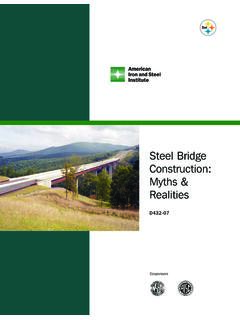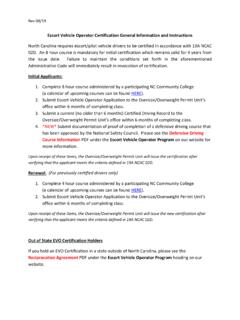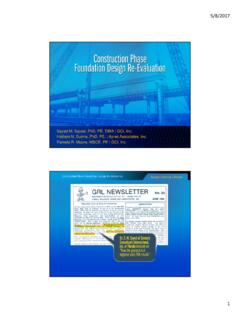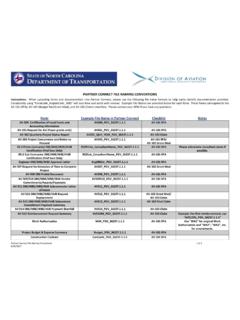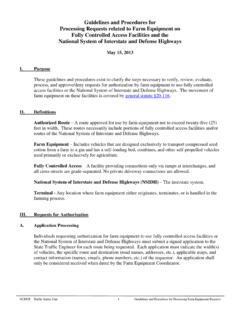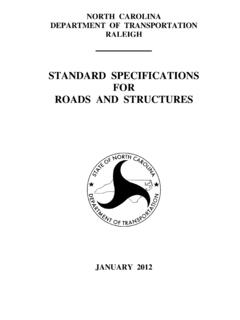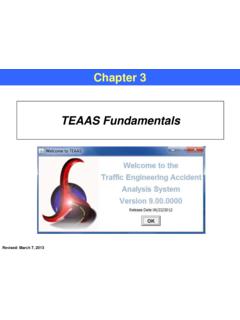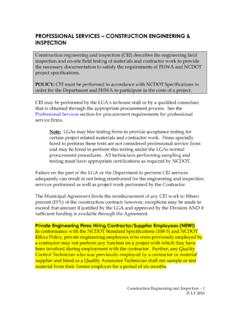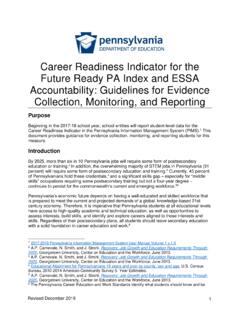Transcription of ROADWAY DESIGN MANUAL PART 1 CHAPTER THREE …
1 ROADWAY DESIGN MANUAL PART 1 REV. 01/02/02 CHAPTER THREE GUARDRAIL, BARRIERS AND ATTENUATORS GUARDRAIL WARRANTS 3-1 Warrants for guardrail are to be in accordance with the "Roadside DESIGN Guide" and with the guardrail warrant curves included in this CHAPTER . In the preliminary DESIGN stage, the designer will establish the location and grade of the project so as to eliminate as much guardrail as possible using these warrants. After location data is received, plans plotted, grades set, and initial templates determined, the following procedures should be followed: (1) Determine Guardrail Locations (a) Is guardrail warranted in accordance with Figure 1 in this CHAPTER ?
2 If not required, go to (c). If required, go to (b). (b) Is guardrail required in accordance with Figures 4 through 6 of this CHAPTER ? If not required, go to (c). (c) Is guardrail warranted in accordance with Table 2 and 3 in this CHAPTER ? Refer to Sheet 1-4M and 1-4N in CHAPTER 1 of this MANUAL . (2) Can Guardrail be eliminated? (a) Can hazard be removed, relocated, or made breakaway? (b) Does a cost effectiveness analysis justify flattening slopes? (Be sure to include the additional costs for right of way, drainage, borrow, erosion control, and clearing, in the initial cost of the slope-flattening alternative.)
3 (c) Will there be an impact on additional wetlands? (3) Determine safety-clearing limits for areas unprotected by guardrail. Refer to Sheet 1-4N in CHAPTER 1 of this MANUAL . (4) Using the safety clearing limits: (a) See pipe end treatment guidelines (5-20 of this MANUAL ) for cross drainage pipe within the safety zone. (b) For large pipes or culverts that have openings within the safety zone, economically justify by use of the cost effectiveness program, either (1) extending the pipes or culverts beyond the safety limits, (2) leaving the drainage as it is without guardrail protection, or (3) using guardrail to protect the hazard.
4 (d) Check the ditch sections for any front slope or back slope located within the clear zone, which is a non-traversable slope. The ditch may remain unshielded if the back slope is smooth and free from hazards. ROADWAY DESIGN MANUAL PART 1 REV. 01/02/02 GUARDRAIL WARRANTS (cont.) 3-1 (e) Check to see that all obstructions within the clear zone are removed, modified for safety, or protected by guardrail.
5 (f) Check landscape plans to be sure that reforestation is not proposed within the safety clearing limits. (g) On low volume , unpaved roadways, guardrail is generally warranted only for bridge rail protection. Refer to Part 1, Section 6-6C of this MANUAL for further information. The following 3 charts (Figures 4 through 6) present two-lane ROADWAY and divided highway guardrail warrant curves for various heights of 2:1 embankments. Each curve represents points of equal cost for the unshielded slope and guardrail.
6 Therefore, a combination of average ADT and warrant slope length which falls above and to the right of a particular curve warrants guardrail. A combination, which falls below and to the left of a particular curve, does not warrant guardrail provided there are no other roadside hazards, which would require a traffic barrier. These curves are based on a DESIGN speed of 60 mph. ROADWAY DESIGN MANUAL PART 1 REV. 01/02/02 ROADWAY DESIGN MANUAL PART 1 REV.
7 01/02/02 TABLES 2 & 3 3- 1 WARRANTS FOR NONTRAVERSABLE HAZARDS T - 2 NONTRAVERSABLE HAZARD WITHIN CLEAR ZONE SEE PART 1,1-4N IN THIS MANUAL TRAFFIC BARRIER REQUIRED YES NO Rough rock cuts X Large boulders X Streams or permanent bodies of water less than 2 ft. in depth X Streams or permanent bodies of water more than 2 ft. in depth X Should drop-off with slope sleeper than 1:1 and (a) Height greater than 2 ft. X (b) Height less than 2 ft.
8 X All roadside obstacles within the clear zone should be removed if possible, otherwise provide barrier protection. WARRANTS FOR FIXED OBJECT T - 3 FIXED OBJECTS WITHIN CLEAR ZONE SEE PART 1,1-4N IN THIS MANUAL TRAFFIC BARRIER REQUIRED YES NO Sign, traffic signal, and luminaire supports ** (a) Concrete base extending 6 in. or more above ground (1) Less than 1,100 lb-sec X (1) Greater than 1,100 lb-sec X+ (b) Breakaway or yielding DESIGN with linear impulse X Rough rock cuts X Large boulders X+ Streams or permanent bodies of water less than 2 ft.
9 In depth X+ Streams or permanent bodies of water more 2 ft. in depth X+ Shoulder drop-off with slope steeper than 1:1 X+ * Fixed object should be removed or relocated so that a barrier is unnecessary, if practical. ** Breakaway or yielding DESIGN is desirable regardless of distance from traveled way. + A Judgment decision. ROADWAY DESIGN MANUAL PART 1 REV. 01/02/02 ROADWAY DESIGN MANUAL PART 1 REV.
10 01/02/02 ROADWAY DESIGN MANUAL PART 1 REV. 01/02/02 ROADWAY DESIGN MANUAL PART 1 REV. 01/02/02 determining GUARDRAIL LENGTHS OF NEED 3-2 After it has been determined, that guardrail is warranted through use of the previous tables and graphs, the next step is to determine the total length of guardrail needed.

